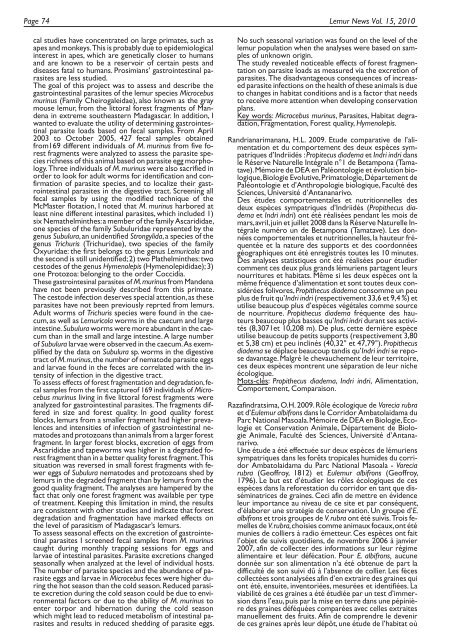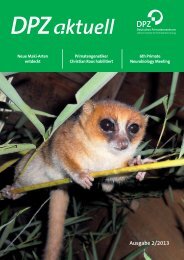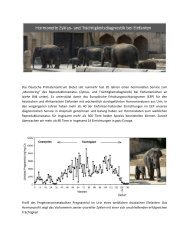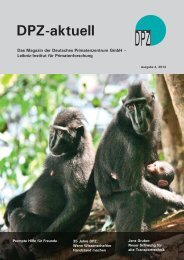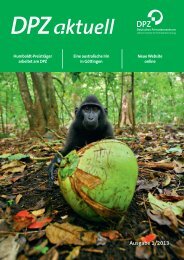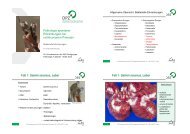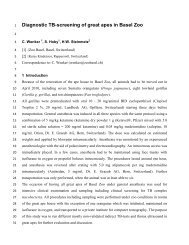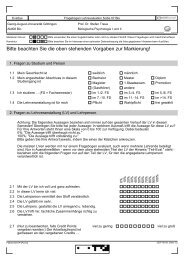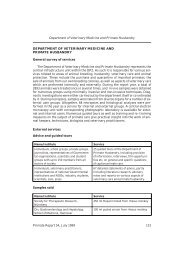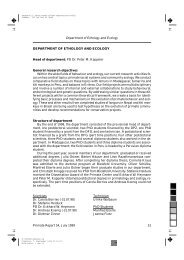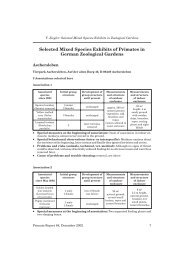Vol. 15 - Deutsches Primatenzentrum
Vol. 15 - Deutsches Primatenzentrum
Vol. 15 - Deutsches Primatenzentrum
You also want an ePaper? Increase the reach of your titles
YUMPU automatically turns print PDFs into web optimized ePapers that Google loves.
Page 74 Lemur News <strong>Vol</strong>. <strong>15</strong>, 2010<br />
cal studies have concentrated on large primates, such as<br />
apes and monkeys.This is probably due to epidemiological<br />
interest in apes, which are genetically closer to humans<br />
and are known to be a reservoir of certain pests and<br />
diseases fatal to humans. Prosimians’ gastrointestinal parasites<br />
are less studied.<br />
The goal of this project was to assess and describe the<br />
gastrointestinal parasites of the lemur species Microcebus<br />
murinus (Family Cheirogaleidae), also known as the gray<br />
mouse lemur, from the littoral forest fragments of Mandena<br />
in extreme southeastern Madagascar. In addition, I<br />
wanted to evaluate the utility of determining gastrointestinal<br />
parasite loads based on fecal samples. From April<br />
2003 to October 2005, 427 fecal samples obtained<br />
from169 different individuals of M. murinus from five forest<br />
fragments were analyzed to assess the parasite species<br />
richness of this animal based on parasite egg morphology.Three<br />
individuals of M.murinus were also sacrified in<br />
order to look for adult worms for identification and confirmation<br />
of parasite species, and to localize their gastrointestinal<br />
parasites in the digestive tract. Screening all<br />
fecal samples by using the modified technique of the<br />
McMaster flotation, I noted that M. murinus harbored at<br />
least nine different intestinal parasites, which included 1)<br />
six Nemathelminthes:a member of the family Ascarididae,<br />
one species of the family Subuluridae represented by the<br />
genus Subulura,an unidentified Strongylida,a species of the<br />
genus Trichuris (Trichuridae), two species of the family<br />
Oxyuridae: the first belongs to the genus Lemuricola and<br />
the second is still unidentified;2) two Plathelminthes:two<br />
cestodes of the genus Hymenolepis (Hymenolepididae);3)<br />
one Protozoa: belonging to the order Coccidia.<br />
These gastrointesinal parasites of M.murinus from Mandena<br />
have not been previously described from this primate.<br />
The cestode infection deserves special attention,as these<br />
parasites have not been previously reprted from lemurs.<br />
Adult worms of Trichuris species were found in the caecum,<br />
as well as Lemuricola worms in the caecum and large<br />
intestine.Subulura worms were more abundant in the caecum<br />
than in the small and large intestine. A large number<br />
of Subulura larvae were observed in the caecum.As exemplified<br />
by the data on Subulura sp. worms in the digestive<br />
tract of M.murinus,the number of nematode parasite eggs<br />
and larvae found in the feces are correlated with the intensity<br />
of infection in the digestive tract.<br />
To assess effects of forest fragmentation and degradation,fecal<br />
samples from the first captureof 169 individuals of Microcebus<br />
murinus living in five littoral forest fragments were<br />
analyzed for gastrointestinal parasites. The fragments differed<br />
in size and forest quality. In good quality forest<br />
blocks, lemurs from a smaller fragment had higher prevalences<br />
and intensities of infection of gastrointestinal nematodes<br />
and protozoans than animals from a larger forest<br />
fragment. In larger forest blocks, excretion of eggs from<br />
Ascarididae and tapeworms was higher in a degraded forest<br />
fragment than in a better quality forest fragment.This<br />
situation was reversed in small forest fragments with fewer<br />
eggs of Subulura nematodes and protozoans shed by<br />
lemurs in the degraded fragment than by lemurs from the<br />
good quality fragment. The analyses are hampered by the<br />
fact that only one forest fragment was available per type<br />
of treatment. Keeping this limitation in mind, the results<br />
are consistent with other studies and indicate that forest<br />
degradation and fragmentation have marked effects on<br />
the level of parasitism of Madagascar’s lemurs.<br />
To assess seasonal effects on the excretion of gastrointetinal<br />
parasites I screened fecal samples from M. murinus<br />
caught during monthly trapping sessions for eggs and<br />
larvae of intestinal parasites. Parasite excretions changed<br />
seasonally when analyzed at the level of individual hosts.<br />
The number of parasite species and the abundance of parasite<br />
eggs and larvae in Microcebus feces were higher during<br />
the hot season than the cold season.Reduced parasite<br />
excretion during the cold season could be due to environmental<br />
factors or due to the ability of M. murinus to<br />
enter torpor and hibernation during the cold season<br />
which might lead to reduced metabolism of intestinal parasites<br />
and results in reduced shedding of parasite eggs.<br />
No such seasonal variation was found on the level of the<br />
lemur population when the analyses were based on samples<br />
of unknown origin.<br />
The study revealed noticeable effects of forest fragmentation<br />
on parasite loads as measured via the excretion of<br />
parasites. The disadvantageous consequences of increased<br />
parasite infections on the health of these animals is due<br />
to changes in habitat conditions and is a factor that needs<br />
to receive more attention when developing conservation<br />
plans.<br />
Key words: Microcebus murinus, Parasites, Habitat degradation,<br />
Fragmentation, Forest quality, Hymenolepis.<br />
Randrianarimanana, H.L. 2009. Etude comparative de l’alimentation<br />
et du comportement des deux espèces sympatriques<br />
d’Indriidés :Propitecus diadema et Indri indri dans<br />
le Réserve Naturelle Intégrale n°1 de Betampona (Tamatave).Mémoire<br />
de DEA en Paléontologie et évolution biologique,Biologie<br />
Evolutive,Primatologie,Département de<br />
Paléontologie et d’Anthropologie biologique, Faculté des<br />
Sciences, Université d’Antananarivo.<br />
Des études comportementales et nutritionnelles des<br />
deux espèces sympatriques d’Indriidés (Propithecus diadema<br />
et Indri indri) ont été réalisées pendant les mois de<br />
mars,avril,juin et juillet 2008 dans la Réserve Naturelle Intégrale<br />
numéro un de Betampona (Tamatave). Les données<br />
comportementales et nutritionnelles,la hauteur fréquentée<br />
et la nature des supports et des coordonnées<br />
géographiques ont été enregistrés toutes les 10 minutes.<br />
Des analyses statistiques ont été réalisées pour étudier<br />
comment ces deux plus grands lémuriens partagent leurs<br />
nourritures et habitats. Même si les deux espèces ont la<br />
même fréquence d’alimentation et sont toutes deux considérées<br />
folivores, Propithecus diadema consomme un peu<br />
plus de fruit qu’Indri indri (respectivement 33,6 et 9,4 %) et<br />
utilise beaucoup plus d’espèces végétales comme source<br />
de nourriture. Propithecus diadema fréquente des hauteurs<br />
beaucoup plus basses qu’Indri indri durant ses activités<br />
(8,3071et 10,208 m). De plus, cette dernière espèce<br />
utilise beaucoup de petits supports (respectivement 3,80<br />
et 5,38 cm) et peu inclinés (40,32° et 47,79°). Propithecus<br />
diadema se déplace beaucoup tandis qu’Indri indri se repose<br />
davantage.Malgré le chevauchement de leur territoire,<br />
ces deux espèces montrent une séparation de leur niche<br />
écologique.<br />
Mots-clés: Propithecus diadema, Indri indri, Alimentation,<br />
Comportement, Comparaison.<br />
Razafindratsima, O.H. 2009. Rôle écologique de Varecia rubra<br />
et d’Eulemur albifrons dans le Corridor Ambatolaidama du<br />
Parc National Masoala.Mémoire de DEA en Biologie,Ecologie<br />
et Conservation Animale, Département de Biologie<br />
Animale, Faculté des Sciences, Université d’Antananarivo.<br />
Une étude a été effectuée sur deux espèces de lémuriens<br />
sympatriques dans les forêts tropicales humides du corridor<br />
Ambatolaidama du Parc National Masoala - Varecia<br />
rubra (Geoffroy, 1812) et Eulemur albifrons (Geoffroy,<br />
1796). Le but est d’étudier les rôles écologiques de ces<br />
espèces dans la reforestation du corridor en tant que disséminatrices<br />
de graines. Ceci afin de mettre en évidence<br />
leur importance au niveau de ce site et par conséquent,<br />
d’élaborer une stratégie de conservation. Un groupe d’E.<br />
albifrons et trois groupes de V.rubra ont été suivis.Trois femelles<br />
de V.rubra,choisies comme animaux focaux,ont été<br />
munies de colliers à radio émetteur. Ces espèces ont fait<br />
l’objet de suivis quotidiens, de novembre 2006 à janvier<br />
2007, afin de collecter des informations sur leur régime<br />
alimentaire et leur défécation. Pour E. albifrons, aucune<br />
donnée sur son alimentation n’a été obtenue de part la<br />
difficulté de son suivi dû à l’absence de collier. Les fèces<br />
collectées sont analysées afin d’en extraire des graines qui<br />
ont été, ensuite, inventoriées, mesurées et identifiées. La<br />
viabilité de ces graines a été étudiée par un test d’immersion<br />
dans l’eau,puis par la mise en terre dans une pépinière<br />
des graines déféquées comparées avec celles extraites<br />
manuellement des fruits. Afin de comprendre le devenir<br />
de ces graines après leur dépôt, une étude de l’habitat où


